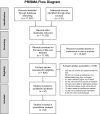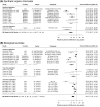The control of malaria vectors in rice fields: a systematic review and meta-analysis
- PMID: 36385495
- PMCID: PMC9668837
- DOI: 10.1038/s41598-022-24055-2
The control of malaria vectors in rice fields: a systematic review and meta-analysis
Abstract
The relatively stable aquatic conditions of irrigated lowland and rainfed rice, which is grown across 145 million hectares in more than 100 countries, are capable of generating large numbers of mosquito vectors of malaria, which causes more than 400,000 deaths per year worldwide. Many methods can control these vectors, but a systematic review has not previously been conducted. This study assesses whether larviciding, fish or intermittent irrigation can significantly reduce malaria vectors in rice fields whilst increasing rice yield. After a literature search for studies reporting the effect of larval control and rice cultivation practices on malaria vector densities in rice fields, 33 studies were eligible for meta-analysis. Larviciding was effective at reducing rice-field malaria vectors. Pooled analysis of five controlled time-series (CTS) studies with chemical insecticides showed an overall combined reduction of larval densities of 77% compared to no larviciding. Eight CTSs with biological larvicides showed a pooled reduction of 60% compared to no larviciding. Cultivating rice and fish together provided good control too: a pooled analysis of three CTSs showed an overall 82% reduction in anopheline larvae compared to no fish. Pooled analysis of four studies suggested that intermittent irrigation (using various timings and frequencies of drainage) is effective at reducing the abundance of late-stage anopheline larvae (pooled reduction = - 35%), but not overall immature abundance, compared to continuous flooding. We conclude that many interventions such as larvicides, fish and intermittent irrigation can provide riceland malaria vector control, but the critical obstacle to wider use is farmer acceptability. Future research should be led by the agricultural sector, with inputs from entomologists, to investigate malaria control co-benefits within high-yielding rice cultivation practices.
© 2022. The Author(s).
Conflict of interest statement
The authors declare no competing interests.
Figures



Similar articles
-
["Farmer Field School", a participatory educational approach for improving the fight against malaria vectors in irrigated rice-growing areas in Benin].Med Trop Sante Int. 2023 Sep 24;3(3):mtsi.v3i3.2023.281. doi: 10.48327/mtsi.v3i3.2023.281. eCollection 2023 Sep 30. Med Trop Sante Int. 2023. PMID: 38094479 Free PMC article. French.
-
Minimal tillage and intermittent flooding farming systems show a potential reduction in the proliferation of Anopheles mosquito larvae in a rice field in Malanville, Northern Benin.Malar J. 2020 Sep 14;19(1):333. doi: 10.1186/s12936-020-03406-2. Malar J. 2020. PMID: 32928223 Free PMC article.
-
Agriculture and the promotion of insect pests: rice cultivation in river floodplains and malaria vectors in The Gambia.Malar J. 2009 Jul 27;8:170. doi: 10.1186/1475-2875-8-170. Malar J. 2009. PMID: 19635125 Free PMC article.
-
The potential of intermittent irrigation for increasing rice yields, lowering water consumption, reducing methane emissions, and controlling malaria in African rice fields.J Am Mosq Control Assoc. 2002 Dec;18(4):329-40. J Am Mosq Control Assoc. 2002. PMID: 12542191 Review.
-
Larviciding to prevent malaria transmission.Cochrane Database Syst Rev. 2019 Aug 14;8(8):CD012736. doi: 10.1002/14651858.CD012736.pub2. Cochrane Database Syst Rev. 2019. PMID: 31425624 Free PMC article.
Cited by
-
Heterogeneous impacts for malaria control from larviciding across villages and considerations for monitoring and evaluation.PLoS Pathog. 2025 Jul 28;21(7):e1013287. doi: 10.1371/journal.ppat.1013287. eCollection 2025 Jul. PLoS Pathog. 2025. PMID: 40720548 Free PMC article.
-
Investigating the Impact of Irrigation on Malaria Vector Larval Habitats and Transmission Using a Hydrology-Based Model.Geohealth. 2023 Dec 10;7(12):e2023GH000868. doi: 10.1029/2023GH000868. eCollection 2023 Dec. Geohealth. 2023. PMID: 38089068 Free PMC article.
-
Field surveys in rural Tanzania reveal key opportunities for targeted larval source management and species sanitation to control malaria in areas dominated by Anopheles funestus.Malar J. 2024 Nov 16;23(1):344. doi: 10.1186/s12936-024-05172-x. Malar J. 2024. PMID: 39548494 Free PMC article.
-
Assessing the Effectiveness of Qista Baited Traps in Capturing Mosquito Vectors of Diseases in the Camargue Region (France) and Investigating Their Diversity.Animals (Basel). 2023 May 30;13(11):1809. doi: 10.3390/ani13111809. Animals (Basel). 2023. PMID: 37409687 Free PMC article.
-
Monitoring individual rice field flooding dynamics over a large scale to improve mosquito surveillance and control.Malar J. 2025 Apr 1;24(1):107. doi: 10.1186/s12936-025-05344-3. Malar J. 2025. PMID: 40170026 Free PMC article.
References
-
- FAO. FAOSTAT Database. (2021).
-
- You L, et al. What is the irrigation potential for Africa? A combined biophysical and socioeconomic approach. Food Policy. 2011;36:770–782.
-
- Lacey, L. A. & Lacey, C. M. The medical importance of riceland mosquitoes and their control using alternatives to chemical insecticides. J. Am. Mosq. Control Assoc. (1990). - PubMed
-
- Mboera LEG, et al. Spatial abundance and human biting rate of Anopheles arabiensis and Anopheles funestus in savannah and rice agro-ecosystems of Central Tanzania. Geospat. Health. 2015;10:322. - PubMed
Publication types
MeSH terms
Grants and funding
LinkOut - more resources
Full Text Sources
Medical
Research Materials
Miscellaneous

